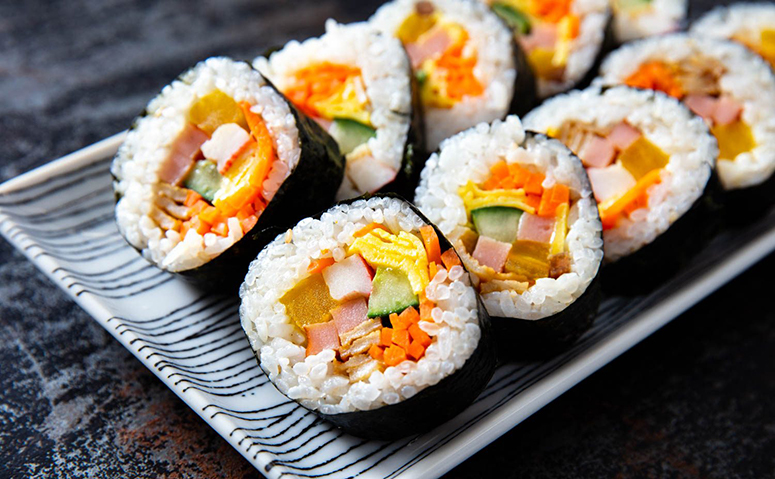A big bite of K-drama
Why are we craving corn dogs, fried chicken with beer, ramen, bibimbap, kimbap and kimchi?
Nowadays, the one food I crave is corndogs — juicy, meaty hotdogs coated in a batter, newly cooked and accompanied by mustard.
Why the random hunger for this amusement-park treat all of a sudden? My answer: Start-Up. I am watching this wonderful K-drama and there is a grandma character that owns a corn dog stand. It’s that simple. This has made me buy the frozen variety in the grocery and have it heated for merienda.

A couple of weeks ago, my friend Maan delightfully surprised me by sending a variety of corn dogs — with cheddar cheese, rice cake and mozzarella. Apparently, I am not alone in this obsession. As a result, there are a couple of Korean corn dog outfits now that deliver. All because of Start-Up.
Korean cuisine has gained much popularity nowadays, thanks in part to K-dramas. Admit it, you enjoy fried chicken and beer like those North Korean soldiers in Crash Landing on You. After seeing all the chicken and beer in dramas, I had to have this combination in Korea. I am not a beer drinker so I chose a fruit-flavored cold beer (my apologies to beer purists) to wash down the sweet and spicy, parmesan-coated, honey mustard, and whatever flavor of fried chicken. It was marvelous.

Especially during the ECQ lockdown, and after watching Lee Min Ho’s The King, where he was perpetually eating chicken, it became a habit to order and have it delivered to my home. I swear, K-dramas are the biggest promoters of their country’s culinary offerings.
Then there is “ramyeon,” which is ramen to you and me. Before I delve into this ubiquitous noodle-soup dish, do you know that asking someone if he/she likes to have ramyeon is actually a pickup line? Well, at least in the dramas. I didn’t pick up on the pickup line at first, but totally got it after some time.

Eating ramyeon is probably in most dramas, but I first noticed it in Boys Over Flowers and Reply 1988. In Encounter, Park Bo-gum and Song Hye-kyo would have it in rest stops between road trips. The instant ramen is cooked in a pot of boiling water. That’s obvious. But then, the noodles are placed on the inverted lid of the pot and eaten there. It serves as a plate. I’ve seen this many times. I guess there will be fewer dishes to wash after.
A discovery for me was “tteokbokki,” which are cylindrical rice cakes simmered in chili paste with the addition of boiled eggs, fish cakes, sausages, cheese, scallions. Some even add Spam. It’s delicious. In almost all K-dramas, there is a child, teenager or adult who has an appetite for tteokbokki. From Princess Hours to I Am Not a Robot, this dish tempts. Now it is a must-order when eating at a Korean restaurant. In my home, we make our own version, too, which is pretty good.

Jjajangmyeon is easier to pronounce than spell. It is a Chinese-Korean noodle dish with a sweet bean sauce mixed with diced pork or seafood. It is usually partnered with sweet-and-sour pork and I can tell you, it’s a great marriage of flavors. I first saw this pairing in Wok of Love, where accomplished chefs sought this dish after preparing the most elaborate feasts. It’s comfort food.
Curious, my friends and I looked for a Chinese restaurant in Gangnam a couple of years ago just to try it. We probably looked like Koreaboos to our tour guide, but we didn’t care. Our stomachs and curiosity reigned and we were not disappointed.

In K-dramas, office colleagues, friends, families and even “kontrabidas” gather in a restaurant where they grill pork, wrap the meat in lettuce and wash it all down with Soju. That dish is samgyupsal. In Weightlifting Fairy Kim Bok-joo, there is a popular scene where Lee Sung Kyung’s character teaches others a technique to maximize the consumption of the dish. However, if it’s a special occasion, beef is the celebratory main course.

There are so many other dishes I discovered via dramas such as kimbap, which is like sushi but with its own Korean fillings; seaweed soup served only on birthdays; bibimbap, a rice mix with chili paste with available vegetables and meats thrown in; and of course, the all-time favorite staple, kimchi. There is also marinated crab, which I still have to try, as shown in When the Camellia Blooms.

As for the food culture in the dramas, it is nice to see rice predominant on the table. Being Asian, rice is life and I can’t live without it. A heaping spoon of rice is the first thing K-actors dig into, followed by a number of side dishes. Side dishes could be various kimchi, soybean, pickled radish, seaweed, potato salad, quail eggs, and omelet rolls. I could go on and on and still would not be able to cover all the side dishes in Korea.

Whether it is dining on a low table with steaming dishes lovingly homemade, simply cooking instant ramyeon in a pot, or eating in traditional restaurants, Korean dramas are a powerful and influential tool that tease tummies and pique the appetites of many.

Banner caption : Kim Sun-ho’s Good Boy character Han Ji-pyeong bites into a corndog in Start-Up.
